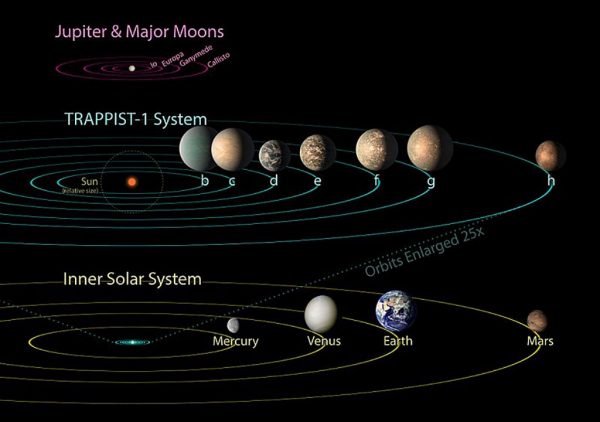
Newsletter Sign Up
Sign up today to our quarterly newsletter
View more

NASA announced recently that with the use of sensitive telescopes, a record number of exoplanets have been detected orbiting a distant single star. The star known as TRAPPIST 1 is theorised to have seven Earth-sized planets in its own solar system.
Some of you may ask, what is an exoplanet? This issue, we will try to explain this term and why astronomers are so interested in the most recent discovery.
As defined by the International Astronomical Union (IAU), an exoplanet (or extrasolar) planet is a planet that orbits a star other than our own Sun. The first detection of an exoplanet occurred in 1988 with the first confirmed detection in 1992 and since then and at the time of writing, there have been 3,583 exoplanets detected in 2,688 solar systems. So planetary systems appear very common in the universe.
Direct observation of an exoplanet is currently impossible due to stars being so far away. However, technology has been able to increase the sensitivity of modern telescopes which has allowed astronomers to detect exoplanets in other ways.

One of the more common ways to detect how much emitted light from a star reduces when a planet passes in front of it. This is called Transit Photometry. An example of this detection method is like when the Moon passes in front of the Sun during an eclipse. If you are in the right spot on Earth, all light from the Sun is blocked by the Moon. The same principle is applied and when a planet passes in front of a distant star, the light being emitted reduces slightly. From this reduction, astronomers are able to calculate the size of the planet orbiting the distant star.
This method is fine provided exoplanets pass in front of the distant star but this is not always the case in the universe.
Another method used to detect exoplanets is for astronomers to measure the amount a star moves when a planet orbits around that star. To explain this, we will use an example of the Earth orbiting the Sun. The Earth orbits around the Sun due to the Sun’s gravitational pull. If there was no gravity, the Earth would go hurtling off into deep space. The Earth also has its own gravity and this pulls on the Sun. As the Earth orbits, the Sun actually moves a little in space. The movement is very minute as the Sun is much larger than the Earth, but nevertheless, the Sun does move which can be detected from a great distance.

This same principle is applied to distant stars and sensitive telescopes can detect small movements in a star as an exoplanet orbits. Depending on the amount of movement, astronomers can calculate the size of the exoplanet.
Initially, in the detection of exoplanets, only very large planets were found. However as sensitivity has increased in recent years, smaller and smaller planets were found.
This week, several Earth-size planets have been detected that are also in a similar situation as our own planet, in that they could support the existence of water and this could potentially support life outside our own Earth. This is the reason that astronomers are very excited.

Sign up today to our quarterly newsletter
View more
Let others know of your experience
View more
Become an awesome volunteer
View more